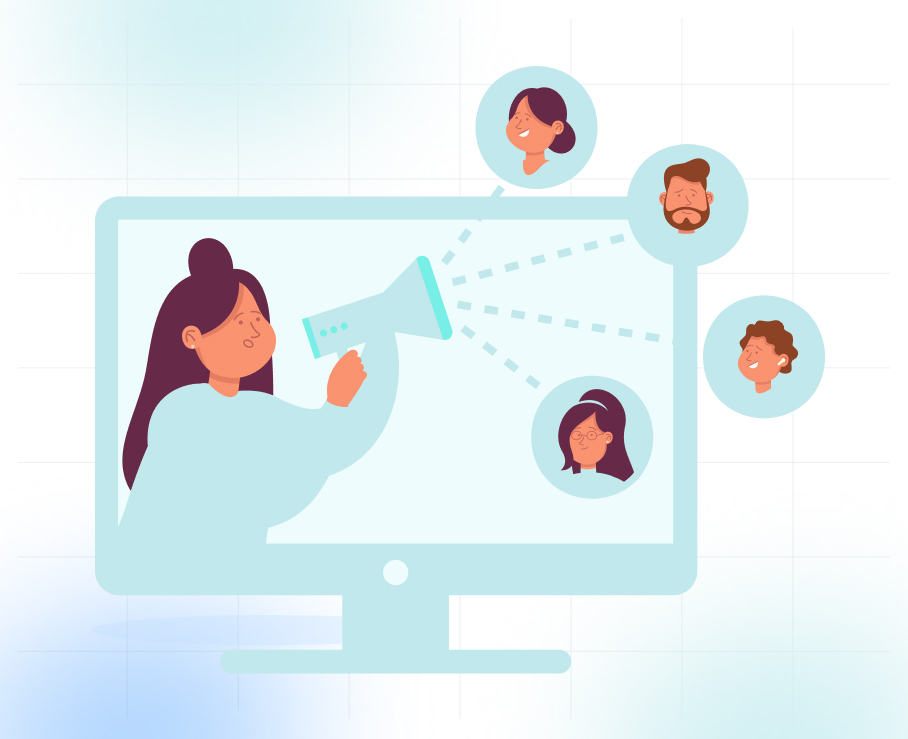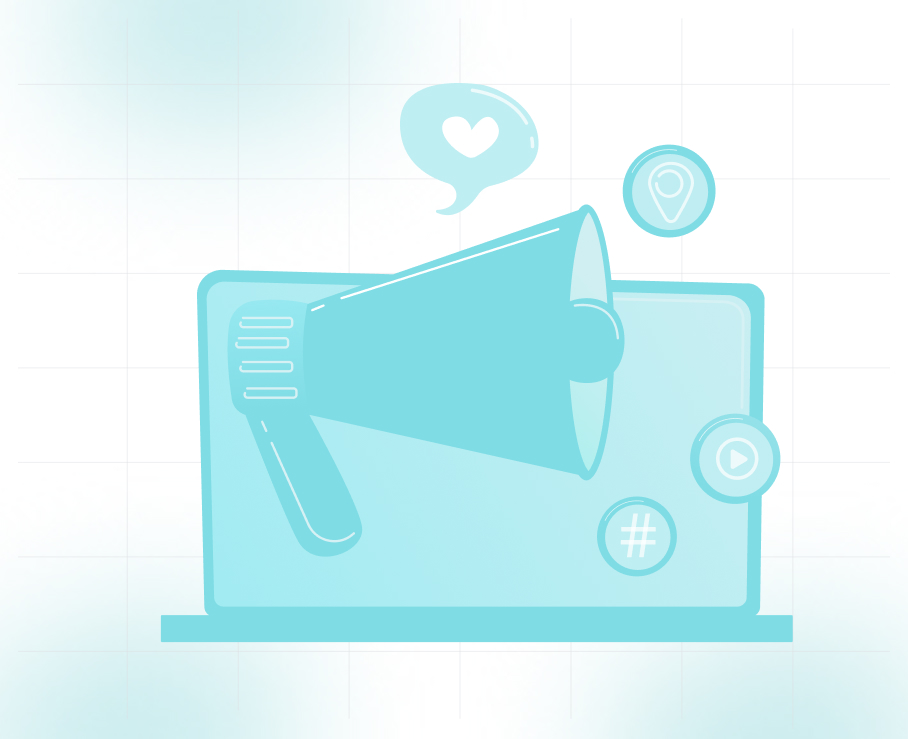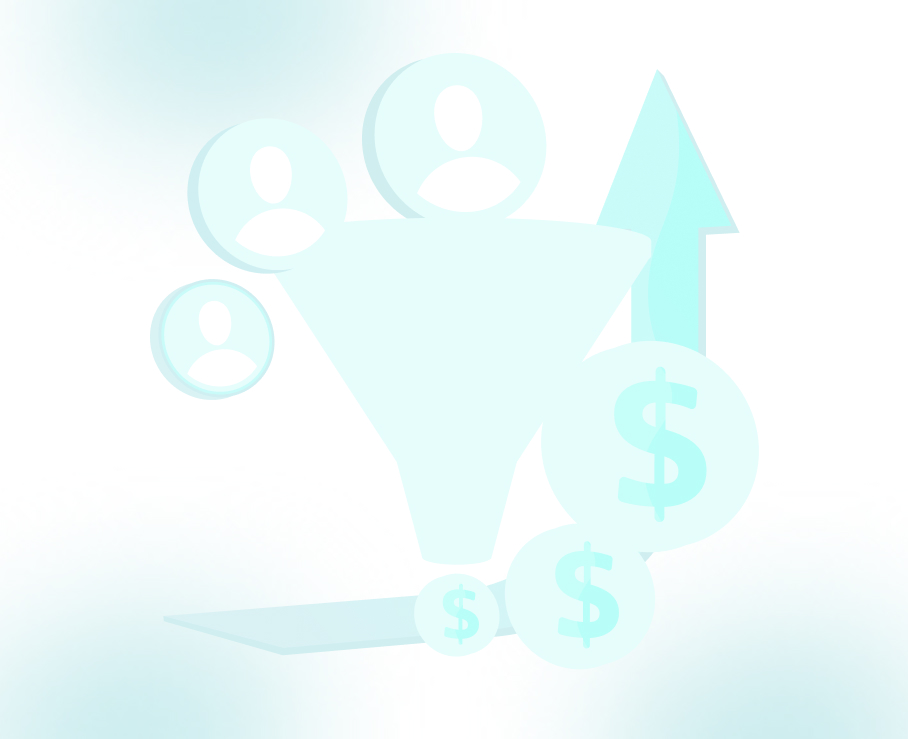
How to Optimize Email Cadence for Better Results?
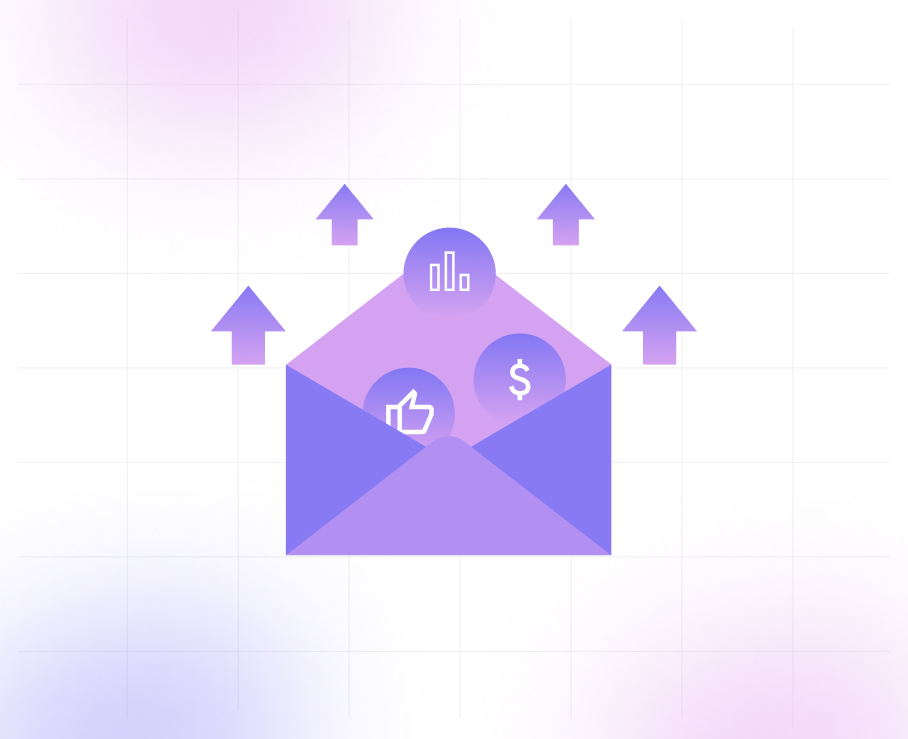
The number of emails sent and received daily stands at an estimated 376.4 billion emails. And that count is expected to rise to over 700 billion emails by 2027. But when it comes to managing email marketing, this number becomes a tricky balance. Sending too many emails can overwhelm your subscribers, and sending too few might cause you to miss out on valuable conversions. So, how do you find the ideal email frequency? The right email cadence is essential for successful email campaigns. It can mean the difference between boosting your open rates and seeing a high unsubscribe rate. In this blog, we’ll walk through how you can determine and implement the best email cadence to see tangible results.
TL;DR
- Email Cadence: The right timing, rhythm, and frequency of emails is key to engaging your audience without overwhelming them.
- Optimizing Cadence: Increase engagement and conversions by adjusting email frequency based on audience preferences and campaign goals.
- Personalization: Tailored content for specific customer segments boosts relevance and results.
- Campaign Adjustments: Analyze past campaigns and test different frequencies to find what works best.
- Tools for Success: Use automation, analytics, and segmentation features to enhance email performance and optimize cadence.
What is Email Cadence?
Email cadence is all about the timing, rhythm, and frequency at which you send emails to your subscribers. Think of it like the tempo of a song. If the pace is too fast, it might be overwhelming; if it’s too slow, the energy fades, and you lose interest.
Your email cadence plays a huge role in whether your messages reach the right people at the right time without feeling like spam. When done right, your emails engage prospects and customers without bombarding them. That balance is key.
When you get the cadence right, the benefits are clear:
- Increased open rates,
- More clicks,
- More conversions
By adjusting your cadence based on the behavior and needs of your subscribers, you’ll create a more satisfying experience for them. This leads to better customer relationships and stronger brand recall.
Key Strategies for Optimizing Your Email Cadence
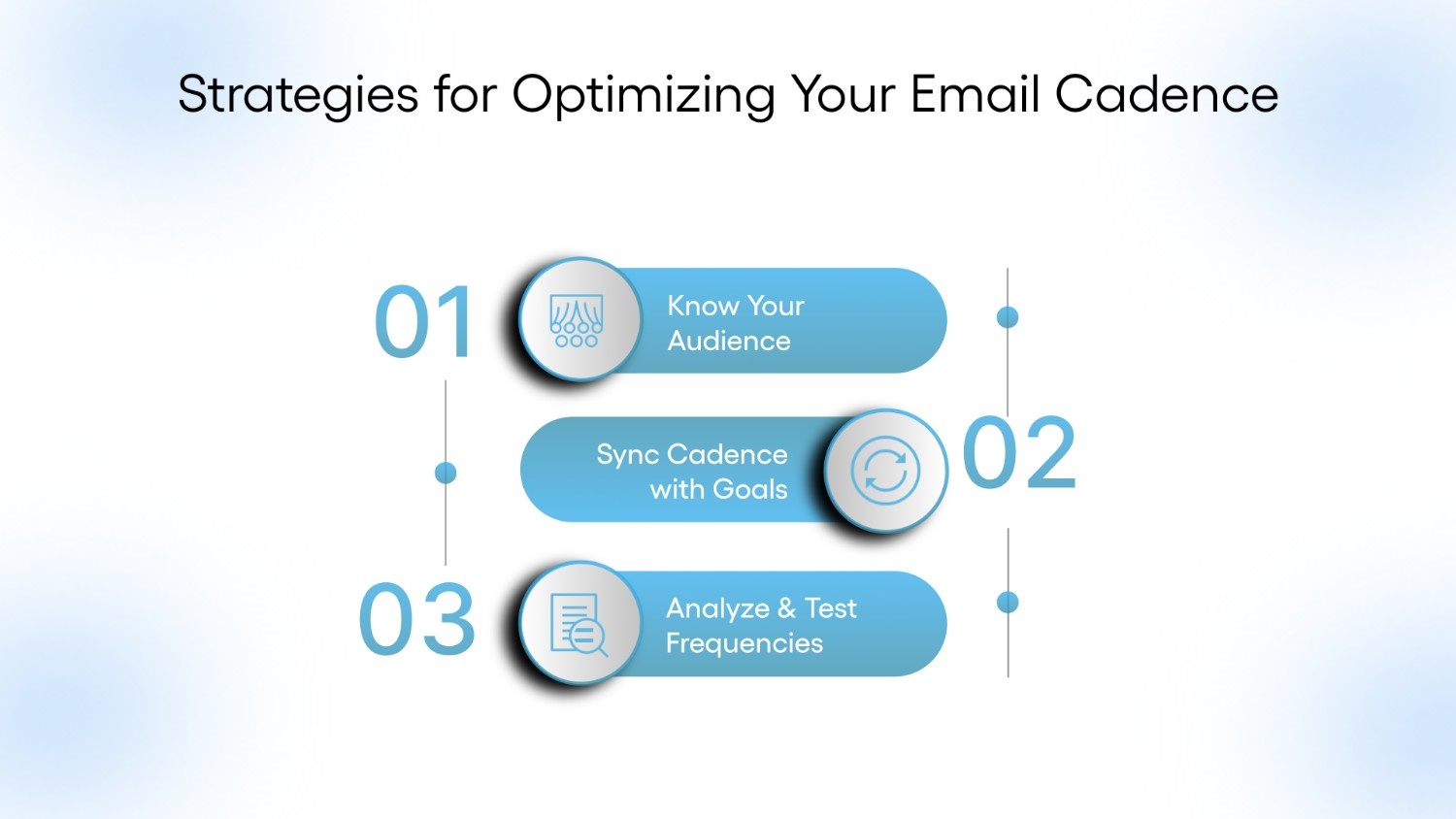
Finding the right cadence isn’t a one-size-fits-all approach. Here are three key strategies to help you fine-tune your email cadence for better results:
1. Understand Your Audience’s Preferences
Knowing your audience inside and out is crucial for determining the right frequency. Here’s how to do it:
- Segment Your Audience: Not all your subscribers are alike. Some might prefer weekly emails, while others might only want a monthly update. Segmenting your list based on engagement levels, demographics, and behaviors helps you tailor the frequency for each group.
- Personalize the Experience: Use behavior triggers to adjust your cadence. For example, subscribers who’ve shown interest in certain content might appreciate more frequent emails.
- Monitor Engagement: Track how often subscribers open emails, click links, or interact with your content to help refine your cadence over time.
2. Align Cadence with Your Campaign Goals
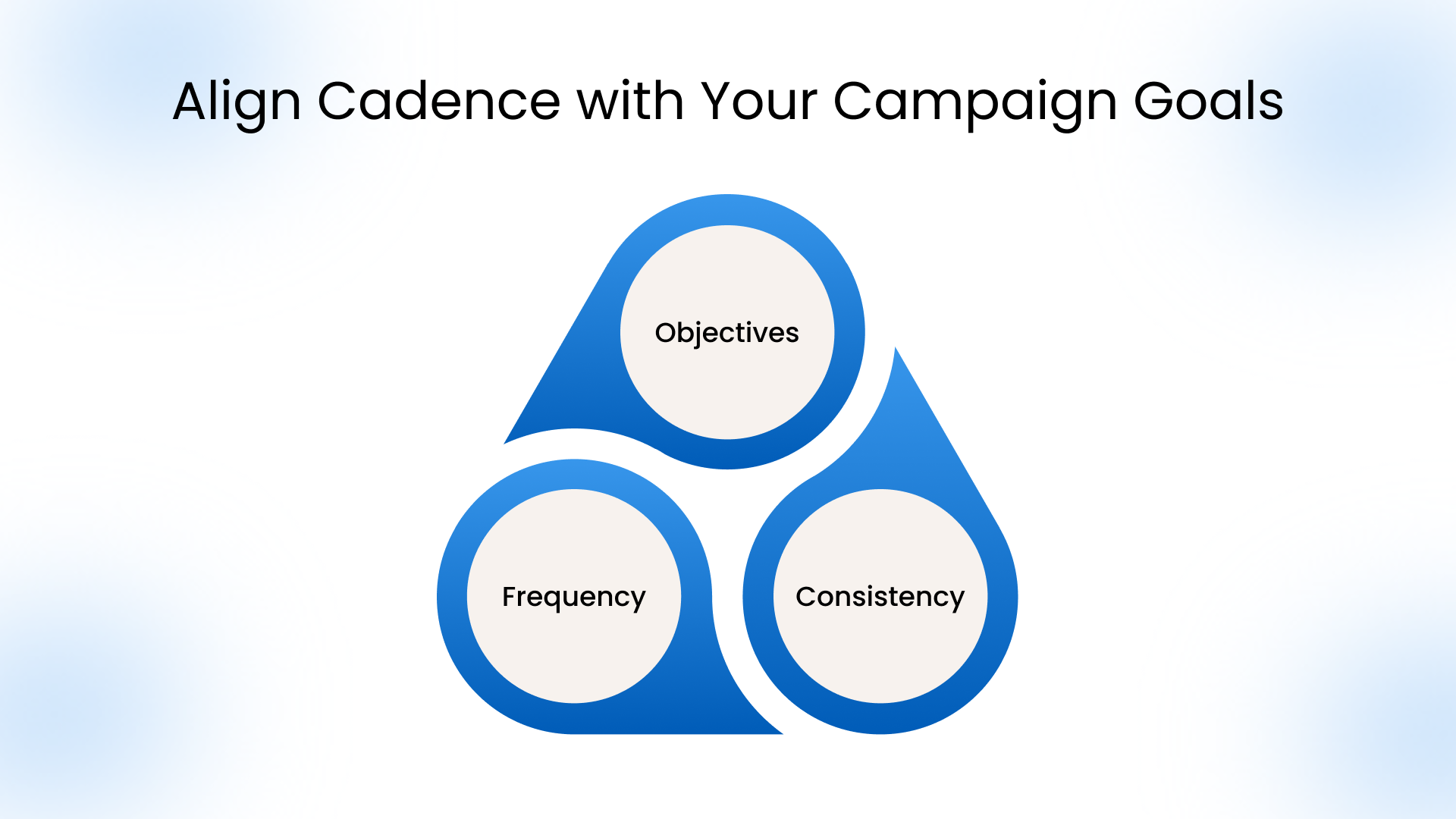
The objectives of your campaign should guide your email cadence, whether it’s driving sales, nurturing leads, or building brand awareness.
- Clear Campaign Objectives: Ask yourself what you want to achieve. Are you trying to generate sales, offer content, or drive traffic to your website? The goal will dictate how often you send emails.
- Adjust Frequency Based on Goals: For example, if you're running a promotional campaign, you might need to send more frequent emails to keep customers engaged. For a nurturing campaign, less frequent emails with high-quality content might be better.
- Consistency is Key: Ensure that your cadence aligns with the level of engagement your audience expects. Don't leave them hanging for too long between emails, or they'll forget about you.
3. Analyze Past Campaigns and Test Different Frequencies
Looking at past data is a great way to see what’s working and what isn’t. Testing different frequencies will help you find the best cadence for your audience.
- Review Historical Data: Dive into your past email campaigns. What’s the open rate like for emails sent weekly versus those sent monthly? Are there any noticeable patterns that can help guide your cadence?
- A/B Testing: A/B testing is essential for testing different sending frequencies. Split your list into smaller segments and experiment with sending emails daily, weekly, or bi-weekly. Monitor which cadence gets the best results.
- Benchmarking: Check industry standards for email frequency. While each business is unique, industry benchmarks can offer valuable insights for setting your initial cadence.
Analyzing past campaigns and testing new frequencies helps you refine your strategy and pinpoint the best cadence for your audience.
Also Read: Email Marketing: Key for B2B Lead Gen and Appointment Setting
Best Practices for Optimizing Email Cadence
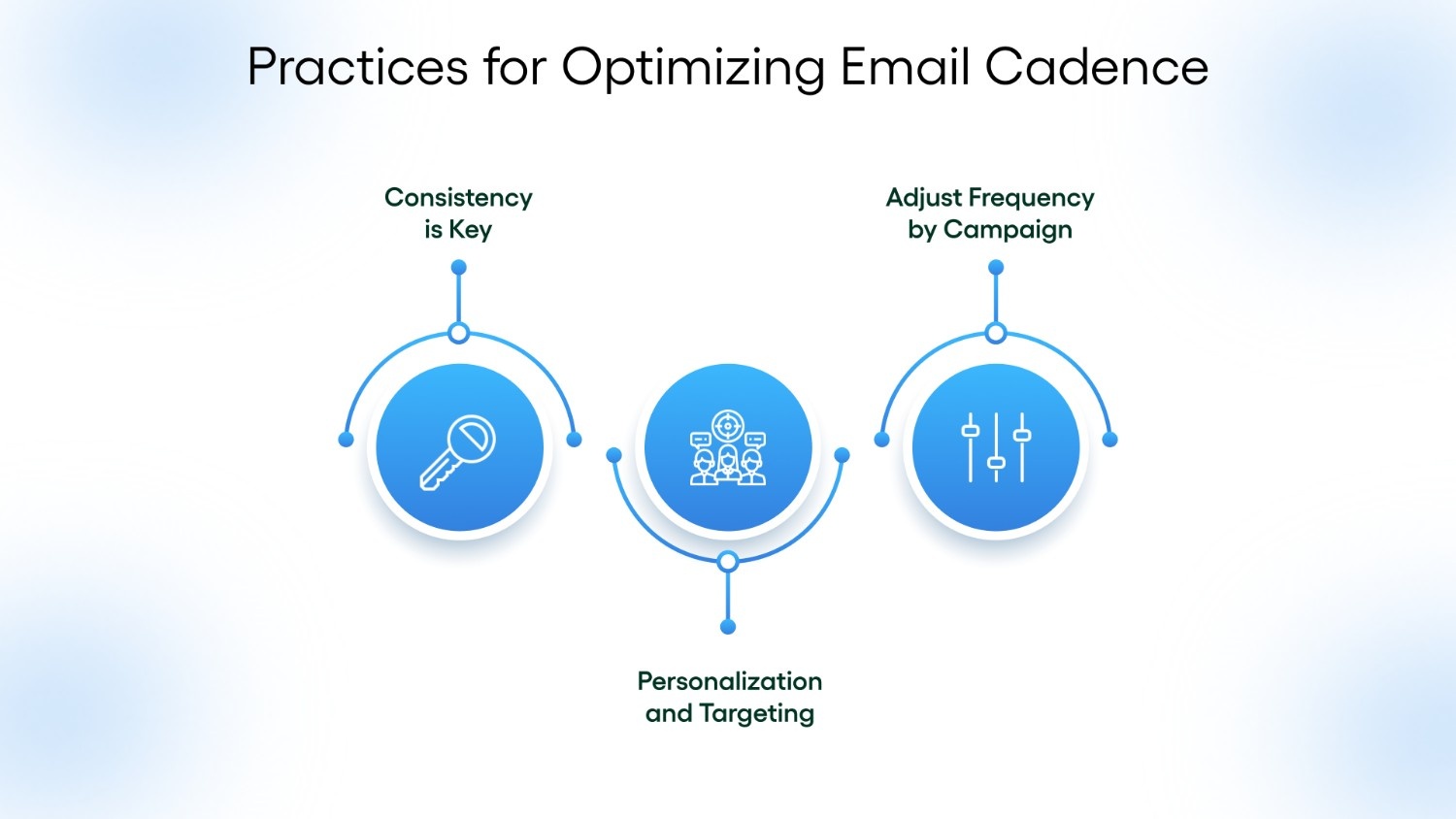
Optimizing your email cadence is crucial for maximizing engagement, conversions, and customer satisfaction. It’s about strategically implementing practices that ensure your emails are well-timed, relevant, and personalized to your audience’s needs. Here are the best practices that will guide you toward optimizing your cadence:
1. Consistency is Key
A consistent email cadence builds trust with your subscribers. When your audience knows when to expect your emails, they’re more likely to engage with them. Whether you’re sending newsletters, promotional emails, or updates, regular communication keeps your brand top of mind and reinforces your relationship with customers.
Pro Tip: Create a content calendar and stick to a predictable schedule. This helps maintain consistency while avoiding email fatigue. For example, try sending a weekly newsletter and bi-weekly promotional emails to strike the right balance.
2. Personalization and Targeting
Personalized emails have a much higher chance of being opened and acted upon. By tailoring content to your audience’s preferences, behaviors, and demographics, you create a more relevant and engaging experience. Segment your audience based on their interaction history, such as targeting new subscribers with a welcome series or offering special promotions to long-time customers. Adjust the frequency for active users and reduce it for those who are less engaged to avoid overwhelming them.
Pro Tip: Use dynamic content in your emails, such as product recommendations based on past purchases. This personalizes the experience and increases the chances of conversions.
3. Adjusting Frequency Based on Campaign Type
The type of campaign you’re running should determine how often you send emails. A promotional campaign, for instance, might benefit from more frequent touchpoints, such as daily emails leading up to a sale. Testing different cadences for each campaign will help you understand what works best for your specific goals.
Pro Tip: Run A/B tests with different cadences for similar campaigns. For instance, test daily emails during a product launch against weekly emails to see which generates more engagement.
By following these best practices, you’ll be able to refine your email cadence, build stronger relationships with your audience, and drive more meaningful conversions.
Also Read: How to Outsource Email Marketing Successfully
Tools You Can Use to Optimize Email Cadence
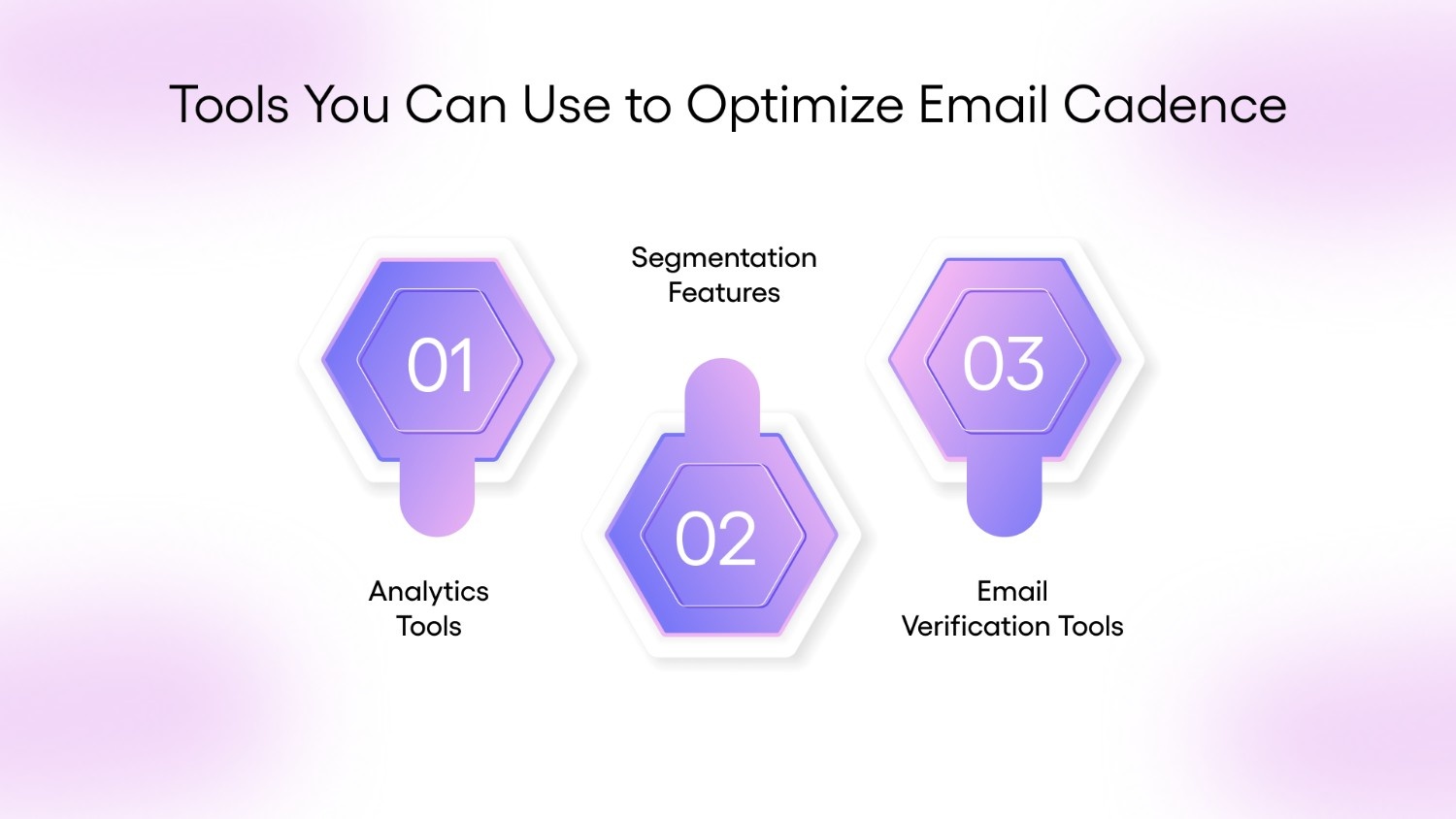
Optimizing your email cadence becomes much easier when you have the right tools at your disposal. The following tools help automate, track, and refine your cadence, leading to more effective email campaigns.
- Analytics Tools: Performance dashboards built into most email platforms help track key metrics like open rates, click-through rates, and conversions. These insights are essential for adjusting your outreach strategy and fine-tuning the timing and messaging of your emails.
- Segmentation Features: Most email platforms offer advanced segmentation tools that help you create targeted campaigns based on subscriber behavior and interests. These features allow for sending the right content at the right frequency, making your emails more relevant.
- Email Verification Tools: Email verification tools help ensure that your email list remains clean and up-to-date by removing invalid or inactive email addresses. By regularly using these tools, you can improve your email deliverability rates and ensure that your campaigns reach an engaged audience.
By using these tools, you can fine-tune your email cadence, ensure your content is targeted, and continuously optimize your email strategy for better results.
How TLM Helped an M&A Advisory Firm Generate Significant Leads Through B2B Email Campaigns
A California-based M&A advisory firm specializing in brokering deals between buyers and sellers in the managed service provider (MSP) industry was facing significant challenges. Despite a decade of experience, they were struggling to generate qualified leads.
When they approached TLM, we introduced a targeted email marketing campaign, focusing on mid-sized MSP companies with 20-150 employees. Using a three-touchpoint strategy and automated scheduling tools, we began generating more meaningful prospects. By the second month, lead generation accelerated to two or three per month, with a total of 13 inquiries. The client expressed satisfaction, stating we had exceeded their expectations.
To achieve such impactful results, TLM applies proven B2B Lead Generation strategies and specialized tools that optimize email marketing campaigns. Our approach ensures that every email sent is part of a strategic, data-driven process designed to generate high-quality leads and promote long-term business growth.
With lead generation, TLM identifies and qualifies high-value prospects, ensuring businesses reach the right audience at the right time. Our targeted campaigning approach uses data-driven strategies to personalize email content and timing, improving engagement without overwhelming recipients.
With TLM's expertise, businesses can fine-tune their email cadence to generate high-quality leads that drive growth and build long-lasting client relationships.
FAQs
1. What is the cadence of an email?
Email cadence refers to the timing and frequency of emails sent to subscribers. The ideal cadence varies by industry, audience, and company to avoid overwhelming or under-engaging recipients.
2. What are the 5 T's of email marketing?
The 5 T’s of email marketing are: Tease, Target, Teach, Test, and Track. These tactics ensure effective campaigns by building anticipation, targeting the right audience, providing value, and monitoring performance.
3. What are the 3 C's of email?
The 3 C's of email are Context, Content, and Contact. They ensure that emails are clear, relevant, and professionally structured, avoiding confusion and making communication effective.
4. What is the best email strategy?
A strong email strategy includes constant testing and optimization. Regularly experiment with subject lines, content, and timing to determine what drives the best open rates, click-throughs, and conversions.


